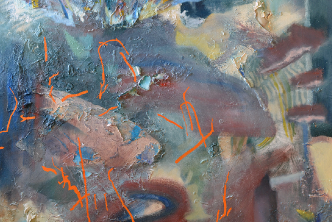“We Are All Slime Molds at Heart” won honorable mention in the DeWitt Wallace Prize for Science Writing for the Public, part of the 2019 Ilona Karmel Writing Prizes.
I’ve been growing slime mold under the couch in my dorm room. In an unlikely twist for a student in Burton Conner, I’m doing it completely intentionally. I scraped a few bright yellow sections from my PI’s culture – she named it “The Real Slime Shady” – into a clear IKEA Tupperware with a thin layer of agar and a scattering of oats a few weeks ago, and he’s been growing contentedly ever since. I named him “There Goes Slimin’ Simon.” Although slime mold usually conjures up images of 1958’s The Blob – “Indescribable… Indestructible! Nothing Can Stop It!” – or 1982’s The Thing – “The ultimate alien terror.” – huge city razing, shape shifting, people eating space monsters, slime molds are actually rather sensitive creatures. Moreover, they’re common and essential parts of Earth’s natural environment. In fact, you’ve probably crossed paths with one or two of Slimin’ Simon’s kind.
If you’ve ever been in the woods, you’re probably familiar with slime mold. Maybe not with its pulsing yellow tendrils or its sporangium – big dandelion-like stalks that cough up spores during the haploid phase of the slime mold’s life cycle – but you’re certainly familiar with its smell. Imagine kicking over an old, rotten stump, stomping it into the forest soil and tearing up its withered root system, white and dense. The smell of decay and of wet wood, the rich, earthy, deep lung-filling aroma of a forest floor: that is Physarum polycephalum.
The name – as most names do – comes from Latin, meaning literally “many-headed slime.” Physarum polycephala are members of the Myxogastria group of amoeboza (“Slime Mold”). They are plasmodial slime molds, meaning that despite their fractal appearance and their macroscopic size, each slime mold is actually just one big cell. This huge cell is basically just a plastic bag full of hundreds of nuclei (Princeton University). Its surface ripples and its shape rocks like a choppy ocean as the internal protoplasmic sea teeming with nuclei sloshes from side to side. That’s actually how slide molds move: through a process called shuttle streaming it uses the rhythmic sloshing of its nuclei and of calcium molecules to propel itself outwards like a pulsating hand outstretching (Deep Look). The calcium molecules create chemical gradients that contract the cell wall, and the slime mold moves by squeezing itself like a water balloon. When this distributed intelligence finds food, it encircles it and secretes digestive enzymes. Its preferred food has been experimentally determined to be porridge oats, and when happy it can grow up to 1cm an hour (TED).
Simon isn’t growing super well right now, though, because he’s battling a bacterial infection, a stubborn black mold that’s growing past and over him to colonize the rest of the Tupperware like some kind of hyper younger sibling trying to squeeze through a door frame first. A lot of slime mold farmers tend to their cultures carefully, using Q-tips dipped in ethanol or tiny plastic fences to ward off invaders, but I’m comfortable letting the two of them duke it out for the time being. Here’s why. First of all, Physarum are pretty resilient. One of my friends grows cultures in big gallon drums in his kitchen – much to the disappointment of his fiancé and soon to be wife. One day, after forgetting to feed the big plasmodium body with oats, he came home to discover that the entire square foot of slime mold had decided to relocate to his kitchen wall. He scrapped it off with a rubber spatula, but it seemed pretty content to continue to grow on the toxic paint on his wall.
Second, Physarum are wicked smart. Physarum are laboratory favorites because each individual is like a million tiny biological computers firing simultaneously. When a slime mold forages for food, it sends out a branching fractal feelers that spread out like unfurling fern fronds. Once it finds resources – a tasty oat, for example – the slime mold retreats its exploring tentacles and solidifies the route to the oat. When scientists first noticed this path searching behavior, they ran Physarum specimens through a gauntlet of puzzles. Physarum aced them all. Slime molds can find the shortest path between two nodes in a weighted graph, and when you put it in a maze with oats at the end, it finds the fastest route to them (Polycephalum physarum). Slime molds even have the computational ability to solve the Tower of Hanoi game – the puzzle where you have to move disks from one rod to another so they end up in the same order – because the game at its heart is a shortest path calculation (Adamatzky). I have a hard time imagining something like Simon actually moving the disks around, however.
In probably the most visually striking experiment, in 2010 researchers from Hokkaido University in Japan got a Physarum culture to crawl into the shape an accurate approximation of the Tokyo rail system just by seeding a petri dish with oats in the locations of major cities (Tero, et al). To many, this experiment confirmed the efficient layout of our cities and transportation systems. If an organism whose instincts had been perfected over millions of years of evolution could replicate our road layouts with minimal input, then surely that implied something natural and ideal about what we had created. It was the golden era of slime mold research. Civil engineers and biologists alike patted themselves on the backs, and baby names that started with Ph -sounds quadrupled in likelihood. People dreamed of replacing silicon logic gates with slime molds. It seemed like there was nothing researchers couldn’t compel slime molds to do, provided they doled out enough oats.
Just like the pax romana, such blissful naiveté was too good to be true. Just last January, Jeff Jones, a senior researcher at the University of the West of England, published a paper on slime mold behavior entitled “Physarum machines imitating a Roman road network: the 3D approach” (Evangelidis, et al). In it, he and others report on a similar experiment to that of their Japanese counterparts, only over a three-dimensional topology of Greece instead of just flat paper towels. The slime mold did its thing once again, connecting the oat cities with strands of protoplasm into a network of sulfur yellow. But this time, the researchers noticed that the Physarum made some mistakes. Like a greedy packing algorithm, the slime molds time and time again prioritized short term gains over long term efficiency. They skirted hills when they should have climbed them, they tumbled down valleys when they should have just walked around. It was a classic case of sacrificing global path minimization for local extrema! The results were troubling to say the least: the slime mold’s behavior was inefficient. More troubling, though, was that Physarum was creating almost perfect copies of the Roman Road. As describes Jones, the slime mold starts in Thessaloniki, “propagates in most of the experiments […] to the north [towards Serdica] and then turns east [towards Phillippopolis] and tries to span and spans remaining settlements with its network of protoplasmic tubes.”
Then in March, Shuai Xu and researchers from Northwestern Polytechnical University in China published “A Physarum-inspired model for the probit-based stochastic user equilibrium problem” (Xu and Jiang). In it, they used a Physarum-inspired model to predict how we drive in traffic. By minimizing something called “perceived travel time” for each traveler, they showed that Physarum actually accurately model the behavior of humans on their morning commutes. The model was inherently imperfect, operating stochastically and without complete knowledge, and there was literally a term form random error in their equations. Again, the slime mold behaved greedily and inefficiently, but once again it was also a great approximation of human behavior.
What Jones and Xu realized was that, far from feeding our egos, slime mold research actually proves what we might fear most about ourselves: that we aren’t special or different from all other forms of life around us. Just like our slimy counterparts, we tend to exploit greedy heuristics in the moment even if those same decisions come back to bite us in our collective plasmodiums. Whether it’s building roads or driving in traffic, at the end of the day, we tend to behave like slime molds. Disorganized, hungry, and impulsive, sure, but also brave, curious, and driven. Slime molds are still used in a lot of scientific applications, but not all of them are focused on technology anymore. Physarum polycephala like Simon and Slime Shady give us a chance to discover new things about ourselves. Not even necessarily in a profound way, either: it’s easy to imagine spreading a slime mold across the roads of an old map to search for hidden cities whose presence is felt only by a subtle tug on the intricate network of roads that is both inherently inefficient, human, and natural.
Works Cited
Adamatzky, Andrew. “Thirty eight things to do with live slime mould.” Cornell University Library, 27 December 2015. Accessed 7 April 2018. https://arxiv.org/abs/1512.08230.
Deep Look. “This Pulsating Slime Mold Comes in Peace (ft. It’s Okay to Be Smart) | Deep Look.” Youtube. 16 April, 2016. Accessed 7 April, 2018. https://www.youtube.com/watch?v=Nx3Uu1hfl6Q.
Evangelidis, Vasilis, et al. “Physarum machines imitating a Roman road network: the 3D approach.” Scientific Reports, 1 April 2017. Nature, doi: 10.1038/s41598-017-06961. Accessed 7 April 2018.
“Physarum polycephalum.” Wikipedia. Wikimedia Foundation. Accessed 7 April 2018. https://en.wikipedia.org/wiki/Physarum_polycephalum.
Princeton University. “John Bonner’s slime mold movies.” Youtube. 22 January 2010. Accessed 7 April 2018. https://www.youtube.com/watch?v=bkVhLJLG7ug.
“Slime Molds.” Wikipedia. Wikimedia Foundation. Accessed 7 April 2018. https://en.wikipedia.org/wiki/Slime_mold.
TED. “Heather Barnett: What humans can learn from semi-intelligent slime.” Youtube. 17 July 2014. Accessed 7 April 2018. https://www.youtube.com/watch?v=2UxGrde1NDA.
Tero, Atsushi, et al. “Rules for Biologically Inspired Adaptive Network Design.” Science vol. 327, 22 January 2010, pp. 439-442. Science, doi: 10.1126/science.1177894. Accessed 7 April 2018.
Xu, Shuai and Wen Jiang. “A Physarum-inspired model for the probit-based stochastic user equilibrium problem.” Elsevier, doi: 1703.01880v1. Accessed 7 April 2018.





